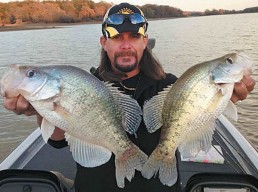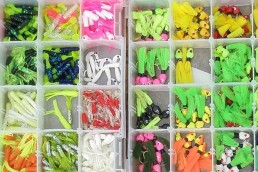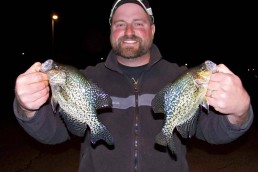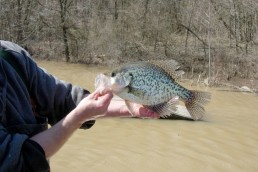Crappie Pro Todd Huckabee Talks Tactics
SHARE THIS POST
What’s the best way to fish for crappies in extremely clear water? Leave it and go find some muddy water, says Todd Huckabee, pro angler and crappie guide.
“On any lake,” says Huckabee, “you can find an area that is not as clear as other parts. You can catch crappies in clear water, but it’s tricky, because crappies are sight feeders. They look at everything. That’s why in all the tournaments, the guys are as far up the creeks and rivers as they can get. They want to fish muddy water, because the crappies are easier to fool.”
To catch crappies in clear water, an angler must downsize, Huckabee said.
“Any time you catch a fish on an artificial, it was a reaction bite, not an actual feeding bite. As a jig is falling in really clear water, a crappie can see it from a long way off and determine that it doesn’t want it. In clear water, you have to downsize and use something that looks natural.”
Huckabee said his job as a guide is to find the most active fish.
“I’m not going to fish clear water,” he said, “because I don’t want to have to trick them into biting. I want to find a big school of fish in muddy water. The more fish there are, the more active they’ll be, because they don’t want the other fish to get the bait first. They’re not sure they want it, but they’re going to suck it in, at least. They’ll spit it out if they don’t want it.”
Hopefully, for your sake, you set the hook before they do.
Crappie travels
“Crappies do not migrate,” Huckabee said, disagreeing with the notion that fish come out of the main body of the lake and move into creeks to spawn. Anglers catch fish in the creeks in March, and in April they’re in the lake, and in May they may be close to the dam.
“People thought the fish were coming out of the creek and migrating into the lake,” says Huckabee, “but it’s totally different fish. They don’t migrate. You can catch fish all the time in the backs of the creeks. There will be days when they’re not active, but that doesn’t mean they’ve left.”
Are you enjoying this post?
You can be among the first to get the latest info on where to go, what to use and how to use it!
Cold front crappies
Cold fronts impact crappies, says Huckabee, but if you seek deeper fish you can still have a good day.
“It will mess them up,” he says, “but you can still catch fish. Just abandon your shallow patterns and look deeper. The deeper the fish, the less they’re influenced by barometric pressure. Go find some fish that are 8- to 10-feet deep, instead of 3-feet deep. Or, if you were catching them at 6 to 7 feet, go find some that are 12- to 14-feet deep.”
How do you fish hot-water lakes?
To be successful on crappies in lakes where water temperatures get extremely warm in summer, Huckabee says “those fish will stay shallow all year. If there’s vegetation, they’ll be on the shallow, flat points at the end of the vegetation.”
Crappie timing
“The best time to catch crappies is the middle of the day,” says Huckabee. “Almost any tournament angler will tell you about the 2 o’clock turn-on. At 3:30, when we have to quit, we’re all wishing we had a few more minutes, because this is when the big ones are biting.”
Crappies start to move in the evening, move through the night and in early morning start moving into cover, according to Huckabee.
“To me,” he says, “they’re easier to catch when they’re in the cover, because I know there are some here and some there. They’re not out roaming around.”
Crappies and moon phase
In the summertime, says Huckabee, pay close attention to moon phases.
During full-moon periods, crappies tend to feed heavily at night. “By daylight,” he says, “they’ve stopped feeding, but they will feed again in the middle of the day, starting about 1 o’clock.
By contrast, crappies tend to feed less at night during the dark of the moon, making early morning and evening key periods to focus your efforts.
MWO
SHARE THIS POST
Did you enjoy this post?
You can be among the first to get the latest info on where to go, what to use and how to use it!
John Meacham
MidWest Outdoors works with more than 200 outdoor experts each year, who contribute articles based on their areas of expertise. MidWest Outdoors magazine offers more fishing and hunting articles than any other publication!



